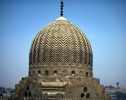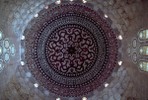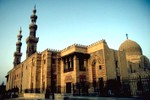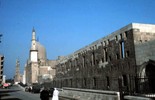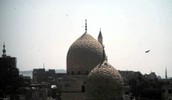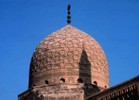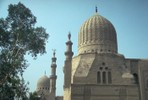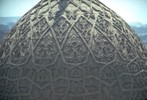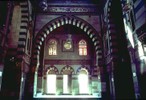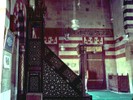Previous Lecture | Next Lecture
Concepts
The Northern Qarafa: What begun under al-Nasir Muhammad as a necropolis north of the Citadel evolved during the Burji period to an extensive urban area running on a north-south axis - which formed the main trade route leading to Syria - parallel to the city of al-Qahira. Numerous amirs and sultans built their funerary complexes there with all sort of services and dependencies of which less than a half still stand today.
The Qubba of Yunus al-Dawadar: (1382) First monument of the Burji period. The only element left of this ruined complex is its elegant and elongated ribbed dome, which echoes the Iranian Ilkhanid domes and prefigures the Timurid domes of Samarkand.
The Khanqah of Sultan Faraj ibn Barquq: (1400-11) One of the largest Mamluk monuments, this complex was the first true urban intervention into what had been until then a desert. It has a mosque with two minarets, a khanqah with numeorus cells for sufis, two sabil-kuttabs, two funerary domes, one for Barquq, the other for his ladies, and many dependencies such as baths, grain mills, and water wheels.
The Funerary Complex of Sultan Barsbay: (1432) A long facade on the main street of the Qarafa which consists of a mosque (with an ugly minaret added later), a mausoleum, two sabils, and a rab` for the sufis.
The Funerary Complex of Sultan Inal: (1451-56) A notable example of the accretive nature of Mamluk architecture: Sultan Inal started it by building himself a funerary dome when he was an amir then went on to add a khanqah, a madrasa/mosque, a sabil and a zawiya after he became sultan.
The Funerary-Religious Complex of Sultan Qaytbay: (1472-74) Perhaps the most beautiful monument of Mamluk Cairo, this complex has a qa`a-type mosque, a madrasa, a mausoleum, and a sabil-kuttab. It was part of a large complex enclosed by a wall of which a rab`, a drinking trough for animals, a saqiya (water-wheel), and a maq`adwhich formed part of a large residence, still stand. The 3-tiered minaret and the carved stone dome with two two superimposed designs are the most accomplished examples of the Burji period.
Monuments


